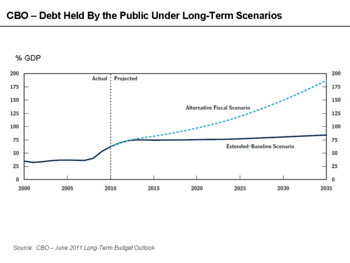
In every presidential election cycle, candidates find themselves called upon to present plans for balancing the federal budget. And, for the most part, their plans call for doing so — in the sweet bye and bye. Never next year, seldom even next decade. The plan is for the current crop of politicians to kick the can down the road some more, leaving it to future Congresses and administrations to exercise the fiscal restraint that these politicians won’t.
Not Carly Fiorina. On MSNBC’s Morning Joe (October 7), Fiorina claimed she would submit a balanced budget to Congress in her first term.
Will she? Probably not, if for no other reason than that she wants to increase, not decrease, spending on the single largest sector of the budget, “defense,” so that she can continue the two previous administrations’ program of idiotic military adventurism around the globe.
But, be that as it may, when she explained how she proposed to attack the budget, she put her finger on one of the biggest bad habits of government spenders and promised to fix it. The problem is something called “baseline budgeting.” She proposes to replace it with “zero-based budgeting.” A quick primer:
Under baseline budgeting, the federal government assumes that each department will spend as much as it spent last year, with an automatic upward adjustment reflecting the inflation rate and US population growth. That’s on rails. The only things that have to be justified in the departments’ budget requests are changes upward or downward from that automatic amount — and how often do you think a bureaucrat requests LESS money?
Under zero-based budgeting, it’s assumed that every last dime requested has to be justified from the ground up. Just because the department spent $100 million on chips, dip and party favors last year, it doesn’t automatically get $102 million for that this year, with the department only having to justify an extra $10 million to buy ponies for all the deputy secretaries (with THAT $10 million forming part of NEXT year’s “baseline”).
The political class, predictably, went ballistic. By the time Fiorina left the set, budget “experts” were loudly reminding us that zero-based budgeting can never work. Why? Well, because the government is just so big and complex that we can’t can’t expect its swarms of bureaucrats to spend time explaining their demands.
The only way to balance the budget, the “experts” say, is to keep automatically forking over more money every year and trust that spending will eventually magically go down on its own. Someday.
Ultimately, balancing a budget is simple: Spend less than you bring in. “Experts” who pretend that zero-based budgeting is out of bounds are the problem, not the solution.
Thomas L. Knapp is director and senior news analyst at the William Lloyd Garrison Center for Libertarian Advocacy Journalism (thegarrisoncenter.org). He lives and works in north central Florida.
PUBLICATION/CITATION HISTORY
- “Score One for Fiorina: A Clarion Call to Budgeting Sanity,” by Thomas L. Knapp, Ventura County, California Citizens Journal, 10/10/15
- “Fiorina’s approach to budget defies establishment,” by Thomas L. Knapp, Libby, Montana Western News, 10/13/15


